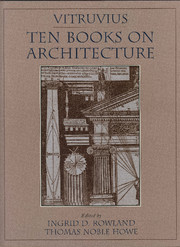Translator's Preface
Published online by Cambridge University Press: 18 December 2014
Summary
Vitruvius is an important writer, quite possibly a highly innovative writer, and certainly among the most influential writers the world has produced, but he is not, perhaps, a very good writer. It is difficult to translate him without at the same time trying to improve his sometimes clumsy phrasing, his endless sentences, his abrupt digressions, and his congenital failure to use one word when he can use two, especially when they sound alike (“evade and avoid” is a typical example). Yet in the middle of the fourteenth century, a reader as sensitive as Petrarch found Vitruvian style perfectly acceptable (although another sensitive reader, Leone Battista Alberti, could lament around 1450 that the Ten Books were such a pastiche of corrupted Latin and Greek that it would have been better if Vitruvius had never written at all).
Vitruvius's chief problems as a writer stemmed from the fact that he was addressing a whole series of different subjects for the first time in Latin. There were no fellow writers to offer him suggestions; often, there were not even words in his own language to describe what he wanted to discuss. Sometimes, as in his treatment of column types in Books 3 and 4 or of war machines in Book 10, he is clearly translating as best he can from Greek authors who have written treatises on a particular subject, but on other occasions, as in his discussion of the Tuscan temple in Book 4, he is just as clearly working entirely on his own. Sometimes these new forays succeed admirably (the description of Tuscan architecture is quite concise); sometimes, however, the fledgling writer abandons a floundering description and simply refers his reader to an illustration at the end of the book, where he promises to draw what he cannot effectively explain.
Vitruvius wrote in an age when writing had already been sharply defined into genres, each with its own appropriate form of expression. In addition, however, the persuasive writer was expected to maintain readers' interest by constant variation in emotional tone and intricacy of language.
- Type
- Chapter
- Information
- Vitruvius: 'Ten Books on Architecture' , pp. xiii - xivPublisher: Cambridge University PressPrint publication year: 1999



